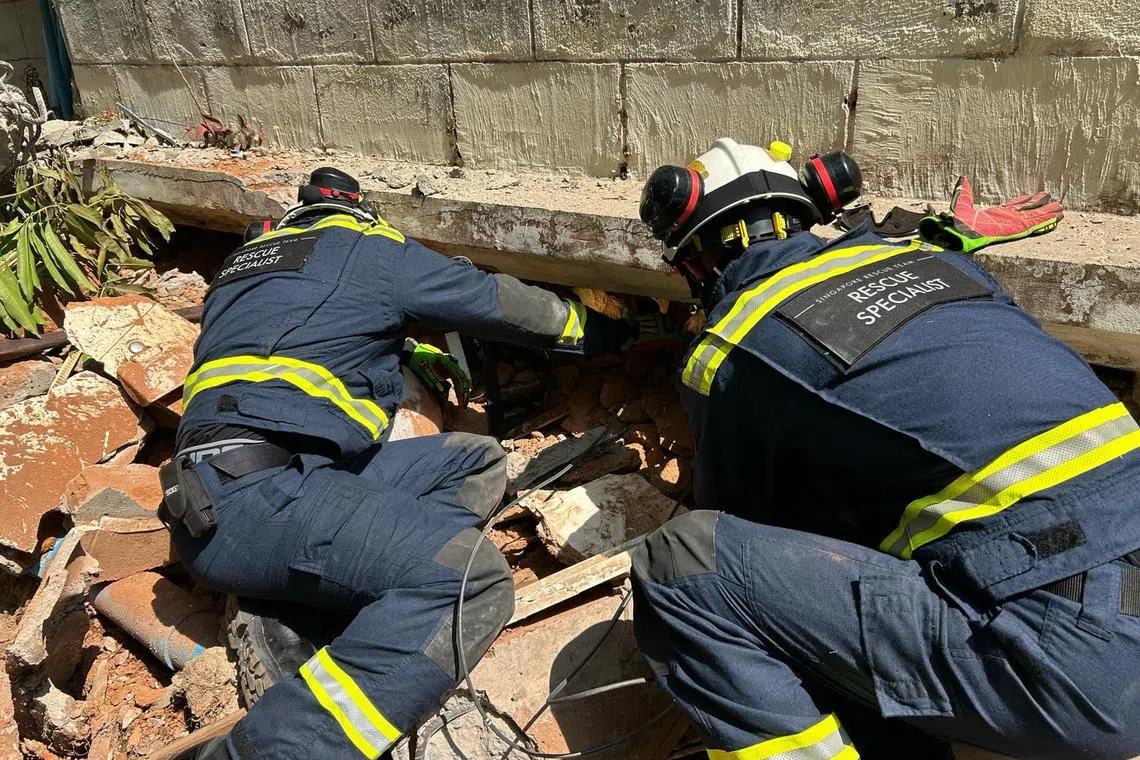S’pore’s cyborg cockroaches helping with search-and-rescue efforts in Myanmar quake
Sign up now: Get ST's newsletters delivered to your inbox

This is the first time in the world such cyborgs have been used in a humanitarian operation.
PHOTO: HTX
Follow topic:
SINGAPORE – A total of 10 cyborg cockroaches from Singapore have been sent to Myanmar to assist with search-and-rescue efforts after a 7.7-magnitude earthquake struck on March 28,
The insects were flown into Myanmar and joined the Singapore Civil Defence Force’s (SCDF) Operation Lionheart contingent
This is the first time in the world such cyborgs have been used in a humanitarian operation.
It is also the first time insect-hybrid robots have been deployed in the field.
The cyborg cockroaches were developed by the Home Team Science and Technology Agency (HTX) together with Nanyang Technological University and Klass Engineering and Solutions.
They were first deployed on March 31 in Myanmar and twice on April 3 in the capital, Naypyitaw.
They have not found any survivors, but the cyborgs have helped the team cover ground in some of the worst-hit areas.
SCDF sent an 80-strong force and four search dogs to Myanmar on March 29.
The HTX team, consisting of two of its engineers and two engineers from Klass Engineering and Solutions, joined the operation a day later with the cockroaches.
Fitted with infrared cameras and sensors, each Madagascar hissing cockroach
Because of their small size, they can navigate tiny spaces under rubble while being controlled remotely.
Electrodes are used to stimulate the cockroaches and control their movements.
The information gathered through their cameras and sensors is processed by a machine-learning algorithm, which can determine if there are signs of life.
This information is then sent back wirelessly to the engineers, helping the team with the deployment of resources.
The cockroaches were featured at the Milipol Asia-Pacific and TechX Summit in Singapore in April 2024, with plans for them to be deployed from around 2026.
Although the cyborgs are still in the research and development stage, the disaster in Myanmar spurred HTX to fast-track the tech to complement SCDF’s efforts.
Speaking from Myanmar, Mr Ong Ka Hing, an engineer from HTX’s Robotics, Automation and Unmanned Systems Centre of Expertise, said the HTX team arrived in Yangon after a three-hour flight and were on the road for another seven hours before joining up with the SCDF.
Speaking to The Straits Times via a video call on April 4, Mr Ong said: “The roads were cracked and we had to take several detours.
“We also saw people displaced from their homes, sleeping in the open, with a lack of food and water. It’s been a surreal experience.”
Their first deployment on March 31 was at a collapsed hospital in an area about the size of two football fields.
SCDF had done a sweep of part of the area with the search dogs and requested that the HTX cockroaches be used to do a deeper check under the rubble, which took them about 45 minutes.

Rescue personnel work at the site of a building that collapsed in Mandalay, Myanmar, on March 29.
PHOTO: REUTERS
The other HTX engineer, Mr Yap Kian Wee, said the mood was sombre when a local resident asked him for help.
Said Mr Yap: “He came to me and said his sibling had been inside the hospital when it collapsed, and said he was hoping we could help find survivors. When I heard this, it was really quite sad.”
Mr Yap said residents had been standing at a distance from the collapsed building the whole day, hoping their loved ones would be found, dead or alive.
He said they saw another team nearby pulling out a body from under the rubble.
The SCDF were able to rescue a man from under a collapsed three-storey building
But rescuers are facing an uphill battle, with temperatures hitting 38 deg C and the prospect of rain, coupled with disruptions to electricity and water supplies.

The SCDF were able to rescue a man from under a collapsed three-storey building after eight hours on March 30.
PHOTO: SCDF
The power supply was cut in the middle of the video call with ST.
Despite the many challenges, Mr Ong and Mr Yap said they will stay on with the SCDF team for as long as they are needed.
They added that the cockroaches remain in good condition, and are surviving on a diet of carrots and water.
Mr Yap said: “We have this sense of mission that makes us want to keep improving on this technology so it can find survivors faster.”
Mr Ong said being deployed in a real-life scenario has been a humbling experience, and he remains optimistic about the technology’s potential.
He said: “Testing in Singapore is very different. It’s a real, dynamic situation here.
“We encountered some technical issues and it hasn’t been smooth sailing. But these are all very valuable lessons that will help us improve for future deployments.”


